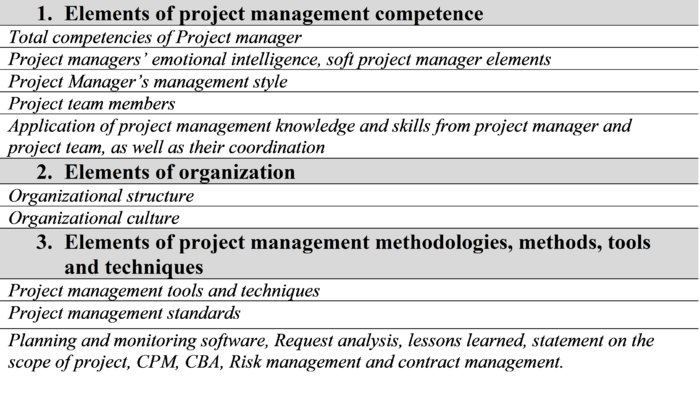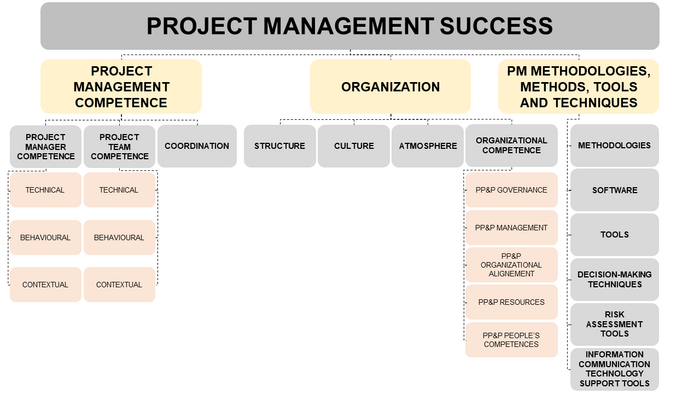Project Management Success Factors
Jonina Thora (Talk | contribs) |
Jonina Thora (Talk | contribs) |
||
| Line 19: | Line 19: | ||
[[File:tafla.png|left|700px|thumb|''Project management success factors (Radujković and Sjekavica, 2017). (Radujković and Sjekavica 2017a).'']] | [[File:tafla.png|left|700px|thumb|''Project management success factors (Radujković and Sjekavica, 2017). (Radujković and Sjekavica 2017a).'']] | ||
| − | |||
| − | |||
| − | |||
| − | |||
| − | |||
| − | |||
| − | |||
| − | |||
| − | |||
| − | |||
| − | |||
| − | |||
| − | |||
| − | |||
| − | |||
| − | |||
| − | |||
| − | |||
| − | |||
| − | |||
Revision as of 14:01, 16 February 2019
Contents |
Abstract
In the theory of a project, there are two main success concepts: project success and project management success. The project management success does indeed contribute massively to a project but does however not guarantee by itself a successful project (Radujković and Sjekavica, 2017a). Several methods and recommendations regarding successful management of projects have been developed throughout time and it is indeed a complex theme, but the benefits gained in a project from the activities of project management are however undeniable. This article will focus on the success factors of project management as well as discuss how implementing the success factors of project management will increase the odds of a successful overall project.
Big Idea
Project management success may be defined as if an intersection of common understanding of all project objectives has been achieved (Alderman and Ivory, 2011).
As for the definition of “project success”, it is a difficult thing to define. Some authors even presume that readers know what is meant by a “project success” and “project failure”. According to Ika (2009), the only certain thing in project management is that “success is an ambiguous, inclusive and multidimensional concept” and the definition of it relies on the context in each project. The success of a project can also be described with words such as efficiency and effectiveness (Ika, 2009).
The success of a project is related to time, cost and quality performance but the time/cost/quality triangle is better known as the “iron triangle” or the “golden triangle” (Ika, 2009). However, many projects have been delivered within time, cost and quality constraints but are still considered as a failure and at the same time other projects have exceeded the triangle constraints but are still be considered as successful projects (Pinto and Slevin, 1988). Therefore, there is a difference between a successful project and project management success. Most authors agree that a success in a project may be achieved through successful project management.
Project management is focused on project performance, regarding short-term dimensions of project success in which the “iron triangle” is indeed one of the aspects, but a project manager is not only responsible for time, cost and quality management but also integration, scope, human resource, communication, risk and procurement management. The role of a project manager is designed in a way in which fits the organization in the same way that the project management processes are designed to fit the project at each time. This role may vary depending on the type of organization and type of project (PMI, 2017). The success of a project management can thus be evaluated through measurements of time, cost and quality but also scope, resource and activity as well as through models of measuring success like PMPA – Project Management Performance Assessment (Kerzner, 2011).
Critical success factors in project management are defined as levers that a project manager can employ in order to increase the odds of a project becoming successful. (Ika, 2009). Several authors have proposed project management success factors throughout time.
Slevin and Pinto (1988) proposed ten key success factors: project mission, top management support, project schedules/plan, client consultation, personnel, technical tasks, client acceptance, monitoring and feedback, troubleshooting, and communication. These factors are managed by the project team respectfully. They then added 4 additional factors to the list which would not fall into the hands of the project’s team: characteristics of the project team leader, power and politics, environmental events, and urgency.
Radujković and Sjekavica (2017) presented a list of project management parts which contribute both to project management success as well as to the overall success of a project. Those parts are stated to be the project management success factors. They are divided into three categories depending on where their focus lies:
The first category consists of technical, behavioural and contextual competencies. The second one has everything to do with the organization, such as organizational structure, organizational culture, organizational atmosphere and organizational competence. The third category consists of six parts: project management methodologies, project management software, project management tools, decision-making techniques, risk assessment tools and information communication technology support tools.
The big idea according to Radujković and Sjekavica (2017a) is that “if you have a competent project manager as well as a competent team, coordinated manager and team, adequate organizational structure, culture, atmosphere and competence, as well as high usage of project management methodologies, methods, tools and techniques, your project should have highly successful project management, and enable project success”.
One must keep in mind that the importance of these success factors varies depending on the project type that the project management team is dealing with at each time. This may concern whether a project is a public or a private project and what the project’s orientation is as well as the number of projects being managed in organization.

